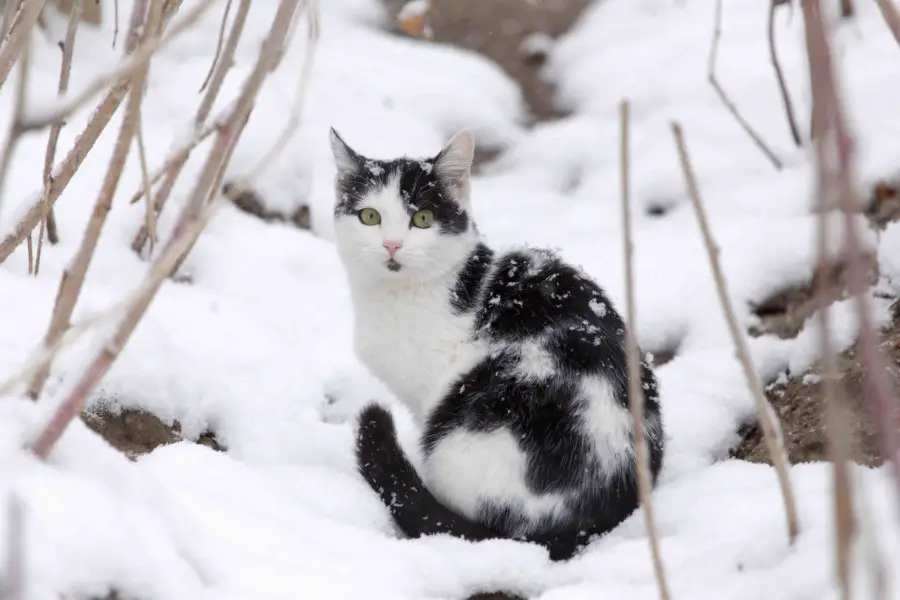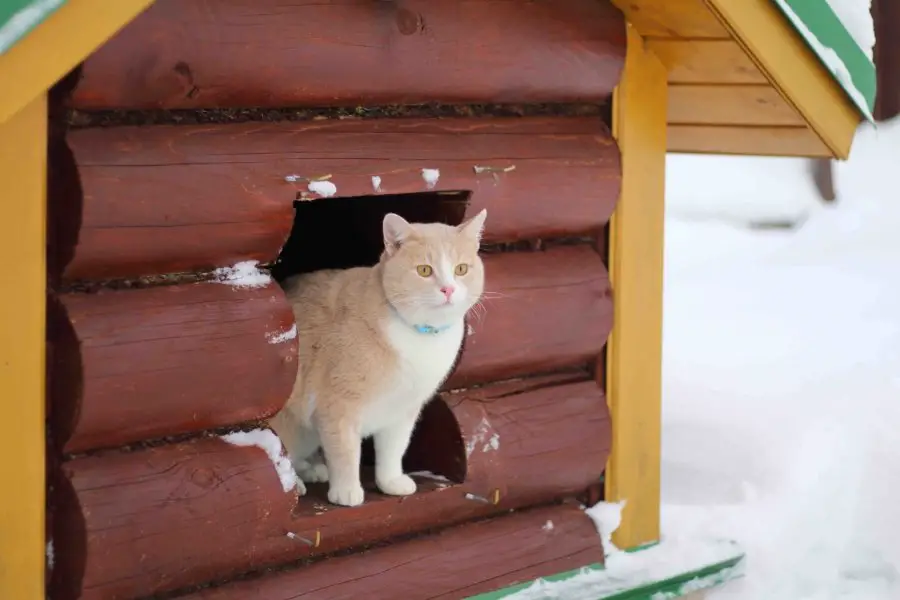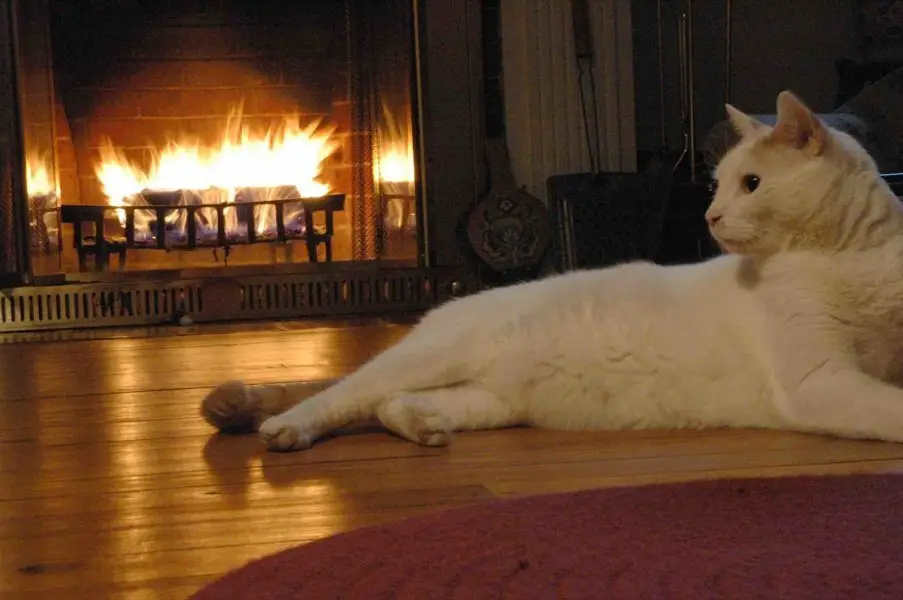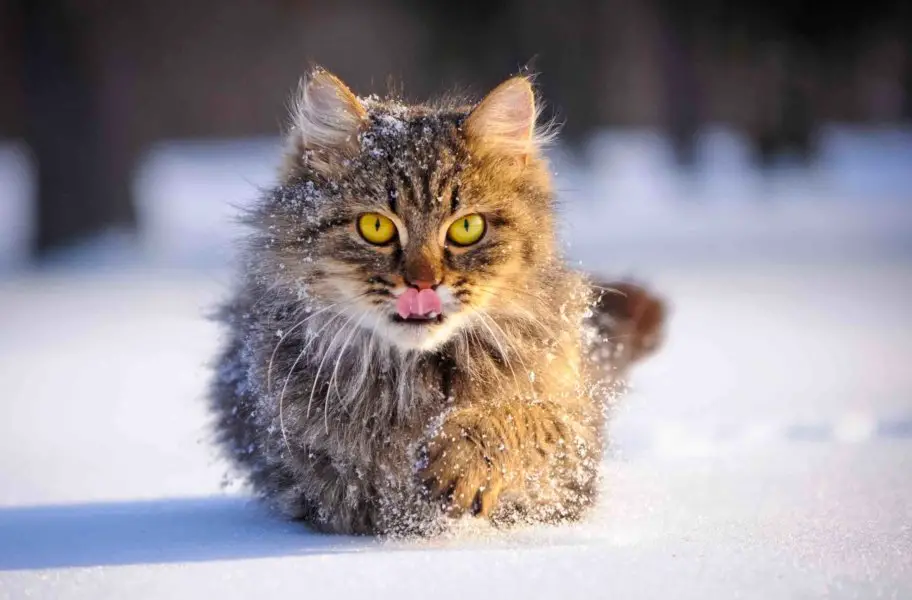Updated January 2024
Guest post by Kristi Davis of Pet Wellness Advisor
Cats have remarkable survival skills. Over thousands and thousands of years, cats in the wild developed skills that have enabled them to not just survive, but to thrive. From desert plains to wild forests, rural backwoods to urban centers, they seem to find a way. Sometimes however, they need a little help from their humans, especially in extreme weather, when many have a hard time surviving.
The “wild” cats most of us interact with today are feral cats. Feral cats are cats that have not been socialized to humans and are typically very fearful of humans. Throughout the year, feral cats generally are more active and cover much more territory than pet cats that roam outdoors. A feral cat may roam over a two-square mile area, while an outdoor pet cat may roam only about four acres.
In the winter, a feral cat spends most of its waking moments just trying to survive—hunting and scavenging for food and water, and finding warm, dry shelter wherever they can. The life of a feral cat is extremely difficult, especially in the harsh winter months, to the point that some organizations such as PETA recommend trapping and euthanasia as the kindest option for feral cats that are not adopted (we disagree). Providing shelter, food and water may be the first steps in getting at least one cat used to your presence, laying the groundwork for eventual trap, neuter, release and in some cases, adoption and taming.

An outdoor pet cat, on the other hand, may have its basic survival needs taken care of by its human, but a pet cat may not be physically conditioned to withstand even the briefest periods of extreme cold.
Whether a cat spends most of its time indoors or outdoors, a little extra help from you can ensure the cat stays safe, warm, and healthy during the winter months. Here are a few tips on how to help both feral cats and your pet cat that spends time outdoors:
Provide fresh water frequently.
Many animals, including cats, become dehydrated in winter when most of the available water supply is frozen. If you can safely provide water in a heated water dish, by all means do so. Heated dishes are available in most pet supply stores or online. If you need to use an extension cord, make sure it is one that is made for outdoor use. If a heated dish is not a viable option, use a thick plastic container, insulated if possible, and change the water frequently. Some people place a microwavable heating pad under the container to help keep it from freezing a little longer.
For indoor cats, frozen water is usually not an issue, but dehydration due to the dry air indoors may be. Be sure to change the water at least daily, and wash your cat’s water dish. Clean, fresh water will tempt your cat to drink more. Feed your cat wet food, which has a higher content of water than does dry food and provides some hydration.
Increase the amount of the cat’s food.
Feral cats will use most of their energy trying to stay warm in the frigid winter months. A regular, ample supply of food will help them conserve the energy they need to stay warm. It will also help their bodies sustain their natural insulation: thick coats and an extra layer of fat. Increase the amount of dry food you are feeding until little remains in the food dish at the time of the next feeding. If you add some wet food to the dish realize it will freeze if the cat does not eat it immediately – making it inedible. Use the best cat food you can afford to ensure the cat meets its wintertime nutritional needs. Consider providing feral cats with dry kitten food as kitten food is high in calories and nutrient-dense.

Provide a warm, clean, dry shelter.
For feral or stray cats, a safe cozy place to shelter from the harsh weather is heavenly. It does not have to be big. Ideally, it will be small enough to trap the cat’s body heat to self-warm the interior. A small dog house works great.
A favorite homemade shelter of some cat rescue organizations is made using Rubbermaid bins with lids. Rubbermaid bins are preferred because they are a good size and they will not crack in the frozen temperatures.
DIY Outdoor Winter Cat Shelter
- To make an outdoor winter cat shelter, cut an entry hole for the cat in one short side of a large Rubbermaid bin. The hole should be no larger than 6 inches in diameter and located a couple of inches above ground level.
- Be sure to place the shelter on a platform of bricks or a pallet or something that keeps it above the ground. This allows the shelter to better trap and hold the cat’s body heat. Prop one end up slightly higher to allow moisture to run off the roof and also to prevent moisture from pooling on the floor inside.
- Depending on your climate, you may need to insulate it. Use Styrofoam cut into panels to fit on the floor and the walls inside the bin, and one to line the ceiling. Straw (not hay) is another great choice for insulation because it allows moisture to drain through it. Stuff straw in the gaps between the Styrofoam panels and the bin walls. Make a drain hole in the shelter floor using a drill or a nail. Consider using some duct tape to keep the lid from blowing off in windy conditions and to help insulate the shelter further.
- Inside the shelter, you will need to provide bedding. It’s preferable to use straw for this as well. If you can provide a heated mat underneath the bedding, the shelter will stay quite warm and the cat will love it. Do not use blankets, newspapers or towels as these will absorb heat and moisture. Once they are wet, they will not provide warmth – they will make the shelter colder.
Check the shelter regularly.
- Remove the lid and look inside. Is it dry? Is it clean? Replace dirty bedding. Keep the entry area clear of snow; otherwise a cat can get trapped outside or inside.

If your cat is an indoor/outdoor cat, make sure she has access to a shelter at all times in case she does not come inside some cold winter night. Adequate shelter can consist of a warm bed in your garage, porch, barn, or other place that is protected from moisture and cold winds.
Indoor cats with plenty of warm cozy places available can still get cold. A heated bed or thermal self-heating mat may be a treat for them. Heated beds are perfect for older, arthritic cats that suffer in cold drafts coming through doors and windows.
Protect the paws.
You can help protect your outdoor cat’s paws from ice and harsh de-icing chemicals by using a little petroleum jelly or even chap stick on the paw pads before she goes outside. Chemicals can be more problematic to cat paws than the snow and ice. When your cat comes indoors, gently clean and towel dry its paws, then dab a little more petroleum jelly on the paws. Be sure your cat is not exposed to anti-freeze as it is lethal even when ingested in tiny amounts (such as licking paws).
It may be more difficult to help protect the paws of feral cats, due to their shy nature. But you can avoid using harsh chemicals on your own property. One easy thing to do is use pet-safe salt on driveways and sidewalks.
Moisturize the skin.
Cats often experience dry itchy skin in the winter. You can help make your pet cat more comfortable by feeding wet food which helps them moisturize from the inside out. You can also try adding a little liquid fish oil to her food. If the cat’s skin is really dry, you should consult your vet to make sure your cat’s dry skin is not a symptom of a more serious problem. Do not use human hair products or skin products on your cat because human products are too harsh for sensitive cat skin. Regularly brushing your cat’s coat will also help distribute the oils down the hair shafts.
We hope you’ll consider implementing a few of these ideas for both feral cats and your own cat, if you allow it to go outdoors. Another easy way to help is to simply share information. Many people want to help, but don’t know how to. Please consider talking to friends and family about the little things they can do to make a big difference. Cats, particularly stray and feral cats, are just trying to survive during the harsh winter months – let’s help them stay warm!!
This blog contains affiliate links. For more information about third-party advertising on this site, please click here.
If you enjoyed this article, consider reading Cold Weather Tips for Pets, How to Build a Cat Igloo, or 4 Tips to Help Cats During the Winter, A DIY Project.
